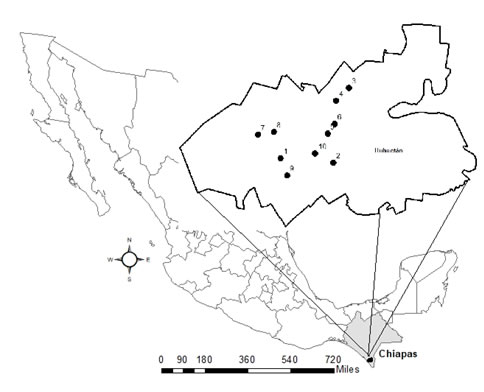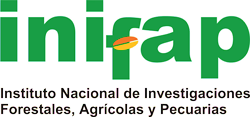Diversity and structure of shadow trees associated with Coffea arabica L. in Soconusco, Chiapas
DOI:
https://doi.org/10.29298/rmcf.v13i71.1191Keywords:
Trees, biodiversity, structure, diversity indicesAbstract
The traditional systems in the coffee (Coffea Arabica) producing areas develop in shady ecosystems with a wide diversity of flora and fauna species. At present, the original floristic composition has been modified by changes in the establishment of a species Inga spp. Therefore, the importance of knowing the diversity and current tree structure of the agroforestry system in coffee cultivation in Soconusco, state of Chiapas arises. For this aim, 10 sampling units (SU) were randomly established in the middle region of Soconusco Chiapas, with dimensions of 1 000 m2 (20 m x 50 m). Variables were recorded to identify their vertical and horizontal stratification, and importance value indexes (IVI), tree species diversity, Shannon-Wiener and Simpson were calculated. 23 tree species were found out of a population of 279 trees and the plantations with the highest chronological age present greater diversity and tree structure. The observed vegetation presents the lower strata ranging from <9 m and upper > 18 m. The species with the greatest presence in the SUs were Tabebuia donnell smithii, Inga micheliana, Cordia alliodora and Cedrela odorata and, according to the Simpson and Shannon diversity indexes, the vegetation that prevails has little tree species diversity. The highest importance value index came from Tabebuia donnell smithii and Inga micheliana.
Downloads
References
Aguirre-Cadena, J. F., J. Cadena-Iñiguez, B. Ramírez-Velarde, B. I. Trejo-Téllez, J. P. Juárez-Sánchez y F. J. Morales-Flores. 2016. Diversificación de cultivos en fincas cafetaleras como estrategia de desarrollo. Caso de Amatlán. Acta Universitaria 26(1):30-38. Doi: 10.15174/au.2016.833. DOI: https://doi.org/10.15174/au.2016.833
Casanova-Lugo, F., L. Ramírez-Avilés, D. Parsons, A. Caamal-Maldonado, A. T. Piñeiro-Vázquez and V. Díaz-Echeverría. 2016. Environmental services from tropical agroforestry systems. Revista Chapingo Serie Ciencias Forestales y del Ambiente 22(3):269-284. Doi: 10.5154/r.rchscfa.2015.06.029. DOI: https://doi.org/10.5154/r.rchscfa.2015.06.029
Colwell, R. K. 2005. Estimaciones: estimación estadística de la riqueza de especies y especies compartidas a partir de muestras. Publicación de la aplicación y la guía del usuario de la versión 7.5. https://purl.oclc.org/estimates (21 de marzo del 2021).
Cox, W. G. 1981. Laboratory manual of general ecology. William C. Brown Co. Publishers. IA, USA. 230 p.
Curtis, H. and R. McIntosh. 1951. An upland forest continuum in the praire-forest border Region of Wisconsin. Ecology 32(3):476-496. Doi: https://doi.org/10.2307/1931725. DOI: https://doi.org/10.2307/1931725
Farfán, V. F. 2014. Agroforestería y Sistemas Agroforestales con Café. Centro Nacional de Investigaciones de Café-Cenicafé. Manizales, Caldas, Colombia. 343 p.
García, E. 1973. Modificaciones al sistema de clasificación climática de Köppen para adaptarlo a las condiciones de la República Mexicana. Instituto de Geografía de la Universidad Nacional Autónoma de México. México, D. F., México. 246 p.
García-Mayoral, L. E., J. I. Valdez-Hernández, M. Luna-Cavazos y R. López-Morgado. 2015. Estructura y diversidad arbórea en sistemas agroforestales de café en la Sierra de Atoyac, Veracruz. Madera y Bosques 21(3):69-82. Doi: 10.21829/myb.2015.213457. DOI: https://doi.org/10.21829/myb.2015.213457
Geissert, D., A. Mólgora-Tapia, S. Negrete-Yankelevich y R. Hunter M. 2017. Efecto del manejo de la cobertura vegetal sobre la erosión hídrica en cafetales de sombra. Agrociencia 51(2):119-133. http://www.scielo.org.mx/pdf/agro/v51n2/1405-3195-agro-51-02-00119.pdf (18 de abril del 2021).
Gómez-Martínez, M. J., G. Díaz-Padilla, F. Charbonnier, G. Sánchez-Viveros y C. R. Cerdán-Cabrera. 2018. Ensambles arbóreos en sistemas agroforestales cafetaleros con diferente intensidad de manejo en Veracruz, México. Revista de Ciencias Ambientales 52(2):16-38. Doi: 10.15359/rca.52-2.2. DOI: https://doi.org/10.15359/rca.52-2.2
Instituto Nacional de Geografía y Estadística (INEGI). 2005. Marco Geoestadístico Municipal, versión 3.1. Prontuario de información geográfica municipal de los Estados Unidos Mexicanos. México. http://www.inegi.org.mx/sistemas/mexicocifras/datos-geograficos/21/21158.pdf (1 de marzo del 2017).
Krishnamurthy, L. y M. Ávila. 1999. Agroforestería básica. PNUMA-FAO. Red de Información Ambiental para América Latina y el Caribe. México D. F., México. 340 p.
López, M., J. M. P. Vázquez, R. Martínez, y M. A. López. 2013. Rentabilidad de fincas de café. In: R. López M., G. Díaz P. y A. Zamarripa C. (Eds.). El sistema producto café en México: problemática y tecnología de producción. INIFAP-CIRGOC. Campo Experimental Cotaxtla. Cotaxtla, Ver., México. 462 p.
Magdaleno M., L., E. García M., J. I. Valdez-Hernández e V. de la Cruz I. 2005. Evaluación del sistema agroforestal "árboles en terrenos de cultivo", en Vicente Guerrero, Tlaxcala, México. Revista Fitotecnia Mexicana 28(3):203-212. https://www.redalyc.org/pdf/610/61028304.pdf (18 de abril del 2021). DOI: https://doi.org/10.35196/rfm.2005.3.203
Martínez, M. A., V. Evangelista, F. Basurto, M. Mendoza y A. Cruz-Rivas. 2007. Flora útil de los cafetales en la Sierra Norte de Puebla, México. Revista Mexicana de Biodiversidad, 78(1):15-40. http://www.scielo.org.mx/pdf/rmbiodiv/v78n1/v78n1a3.pdf (18 de abril del 2021).
Miranda, F. 2015. La vegetación de Chiapas. Ed. Universidad de Ciencias y Artes de Chiapas. Tuxtla Gutiérrez, Chis., México. 686 p.
Moguel, P. y V. M. Toledo. 2004. Conservar produciendo: biodiversidad, café orgánico jardines productivos. Biodiversitas 55:2-7. http://200.12.166.51/janium/Documentos/4697.pdf (18 de abril de 2021).
Pielou, E. C. 1969. An Introduction to Mathematical Ecology. Wiley-Interscience. New York, NY, USA. 400 p.
Pennington, T. D. y J. Sarukhan. 2005. Árboles tropicales de México. Manual para la identificación de las principales especies. Ediciones Científicas Universitarias. Universidad Nacional Autónoma de México y Fondo de Cultura Económica. México, D. F., México. 523 p.
Pérez-Fernández, Y., M. V. González-Santiago, E. Escamilla-Robledo, A. Cruz-León, M. Rosas-Brugada y F. de J. Ruiz-Espinoza. 2016. Propuestas para la preservación de la vida en los cafetales en el municipio de Teocelo, Veracruz. Revista de Geografía Agrícola 57:7-16. Doi: 10.5154/r.rga.2016.57.007. DOI: https://doi.org/10.5154/r.rga.2016.57.007
Pérez-Nieto, J., E. Valdés-Velarde y V. M. Ordaz-Chaparro. 2012. Cobertura vegetal y erosión del suelo en sistemas agroforestales de café bajo sombra. Terra Latinoamericana 30(3):249-259. http://www.scielo.org.mx/pdf/tl/v30n3/2395-8030-tl-30-03-00249.pdf (18 de abril del 2021).
Reyes-Reyes, J. y J. López-Upton. 2003. Crecimiento del cedro rosado (Acrocarpus fraxinifolius Wight. & Arn.) a diferentes altitudes en fincas cafetaleras del Soconusco, Chiapas. Revista Chapingo Serie Ciencias Forestales y del Ambiente 9(2):137-142. https://www.redalyc.org/pdf/629/62913142005.pdf (18 de abril del 2021).
Roa-Romero, H. A., M. G. Salgado-Mora y J. Álvarez-Herrera. 2009. Análisis de la estructura arbórea del sistema agroforestal de cacao (Theobroma cacao L.) en el Soconusco, Chiapas – México. Acta Biológica Colombiana 14(3):97-110. https://revistas.unal.edu.co/index.php/actabiol/article/viewFile/12599/13199 (18 de abril de 2021).
Sáenz Reyes, J. T., J. A. González-Torres, J. Jiménez-Ochoa, A. Larios-Guzmán, M. Gallardo-Valdez, F. J. Villaseñor-Ramírez y C. Ibáñez-Reducindo. 2010. Alternativas agroforestales para reconversión de suelos forestales. Folleto Técnico Núm. 18. SAGARPA-INIFAP-CIRPAC. Campo Experimental Uruapan. Uruapan, Mich., México. 52 p.
Salgado-Mora, M. G., C. Ruiz-Bello, J. L. Moreno-Martínez, B. Irena-Martínez y J. F. Aguirre-Medina. 2018. Captura de carbono en biomasa aérea de árboles de sombra asociados a Coffea arabica L. en el Soconusco Chiapas. Agroproductividad 11(2):120-126. https://revista-agroproductividad.org/index.php/agroproductividad/article/view/136/114 (11 de abril del 2021).
Salvador-Morales, P., L. del C. Cámara-Cabrales, J. L. Martínez-Sánchez, R. Sánchez-Hernández y E. Valdés-Velarde. 2019. Diversidad, estructura y carbono de la vegetación arbórea en sistemas agroforestales de cacao. Madera y Bosques 25(1):1-14. Doi: 10.21829/myb.2019.2511638. DOI: https://doi.org/10.21829/myb.2019.2511638
Sánchez-Gutiérrez, F., J. Pérez-Flores, J. J. Obrador-Olan, A. Sol S. y O. Ruiz-Rosado. 2016. Estructura arbórea del sistema agroforestal cacao en Cárdenas, Tabasco, México. Revista Mexicana de Ciencias Agrícolas, Pub. Esp. 14: 2695-2709. Doi: 10.29312/remexca.v0i14.439. DOI: https://doi.org/10.29312/remexca.v0i14.439
Somarriba, E. 1999. Diversidad Shannon. Agroforestería en las Américas 6(23):72-74. http://repositorio.bibliotecaorton.catie.ac.cr/handle/11554/7586 (18 de abril del 2021).
Somarriba, E. y J. Beer, J. 1999. Sistemas agroforestales con cacao en Costa Rica y Panamá. Agroforestería en las Américas 6(22):1-5. https://repositorio.catie.ac.cr/bitstream/handle/11554/6816/Sistemas_agroforestales_con_cacao_en_Costa_Rica_Panama.pdf?sequence=1&isAllowed=y (18 de abril del 2021).
Stiling, P. 1999. Ecology; Theories and Applications. 3rd edition. Prentice Hall. NJ, USA. 840 p.
Villavicencio-Enríquez, L. 2013. Caracterización agroforestal en sistemas de café tradicional y rústico, en San Miguel, Veracruz, México. Revista Chapingo Serie Ciencias Forestales y del Ambiente 19:67-80. Doi: 10.5154/r.rchscfa.2010.08.051. DOI: https://doi.org/10.5154/r.rchscfa.2010.08.051
Villavicencio-Enríquez, L. y J. I. Valdez-Hernández. 2003. Análisis de la estructura arbórea del sistema agroforestal rusticano de café en San Miguel, Veracruz, México. Agrociencia 37(4):413-423. https://www.redalyc.org/pdf/302/30237410.pdf (18 de abril del 2021).
Zapata A., P. C. 2019. Composición y estructura del dosel de sombra en sistemas agroforestales con café de tres municipios de Cundinamarca, Colombia. Ciência Florestal 29(2):685-697. Doi: 10.5902/1980509827037. DOI: https://doi.org/10.5902/1980509827037
Zarco-Espinosa, V. M., J. I. Valdez-Hernández, G. Ángeles-Pérez y O. Castillo-Acosta. 2010. Estructura y diversidad de la vegetación arbórea del Parque Estatal Agua Blanca, Macuspana, Tabasco. Universidad y Ciencia 26(1):1-17. http://www.scielo.org.mx/pdf/uc/v26n1/v26n1a1.pdf (18 de abril del 2021).

Published
How to Cite
Issue
Section
License
Copyright (c) 2022 Revista Mexicana de Ciencias Forestales

This work is licensed under a Creative Commons Attribution-NonCommercial 4.0 International License.
The authors who publish in Revista Mexicana de Ciencias Forestales accept the following conditions:
In accordance with copyright laws, Revista Mexicana de Ciencias Forestales recognizes and respects the authors’ moral right and ownership of property rights which will be transferred to the journal for dissemination in open access.
All the texts published by Revista Mexicana de Ciencias Forestales –with no exception– are distributed under a Creative Commons License Attribution-NonCommercial 4.0 International (CC BY-NC 4.0), which allows third parties to use the publication as long as the work’s authorship and its first publication in this journal are mentioned
The author(s) can enter into independent and additional contractual agreements for the nonexclusive distribution of the version of the article published in Revista Mexicana de Ciencias Forestales (for example, include it into an institutional repository or publish it in a book) as long as it is clearly and explicitly indicated that the work was published for the first time in Revista Mexicana de Ciencias Forestales.
For all the above, the authors shall send the form of Letter-transfer of Property Rights for the first publication duly filled in and signed by the author(s). This form must be sent as a PDF file to: ciencia.forestal2@inifap.gob.mx
This work is licensed under a Creative Commons Attribution-Noncommercial 4.0 International license.





